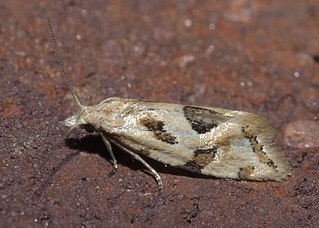
The Tortricidae are a family of moths, commonly known as tortrix moths or leafroller moths, in the order Lepidoptera. This large family has over 11,000 species described, and is the sole member of the superfamily Tortricoidea, although the genus Heliocosma is sometimes placed within this superfamily. Many of these are economically important pests. Olethreutidae is a junior synonym. The typical resting posture is with the wings folded back, producing a rather rounded profile.

The Archipini are a tribe of tortrix moths. Since many genera of these are not yet assigned to tribes, the genus list presented here is provisional.

Chlidanotinae is a subfamily of moths in the family Tortricidae.

The Cochylini are a tribe of tortrix moths. It used to be classified as the subfamily Cochylinae.

Argyrotaenia is a genus of moths in the tribe Archipini within the family Tortricidae.
Agriophanes is a genus of moths belonging to the subfamily Olethreutinae of the family Tortricidae, with a single species found in India.
Omiostola is a genus of moths belonging to the subfamily Olethreutinae of the family Tortricidae.

Aethes is a genus of moths belonging to the subfamily Tortricinae of the family Tortricidae.

Cochylis is a genus of moths belonging to the subfamily Tortricinae of the family Tortricidae.

Phalonidia is a genus of moths belonging to the subfamily Tortricinae of the family Tortricidae.

Eugnosta is a genus of moths belonging to the family Tortricidae.

The Euliini are a tribe of tortrix moths.

The Olethreutini are a tribe of tortrix moths.
Alexey Nikolaievich Diakonoff, also transliterated as Alexej Nikolajewitsch Diakonoff, was a Russian–Dutch entomologist who specialised in Microlepidoptera.
Omiostola hemeropis is a species of moth of the family Tortricidae. It is found in Colombia and Ecuador. Omiostola macrotrachela was synonymized with O. hemeropis by Razowski and Becker, 2016.
Omiostola triangulifera is a species of moth of the family Tortricidae. It is found in Colombia and Pichincha Province, Ecuador.
Omiostola basiramula is a species of moth of the family Tortricidae. It is found in Colombia.
Omiostola detodesma is a species of moth of the family Tortricidae. It is found in Colombia.
Omiostola brunneochroma is a species of moth of the family Tortricidae. It is found in Carchi Province, Ecuador.
Omiostola delta is a species of moth of the family Tortricidae. It is found in Carchi Province, Ecuador.










